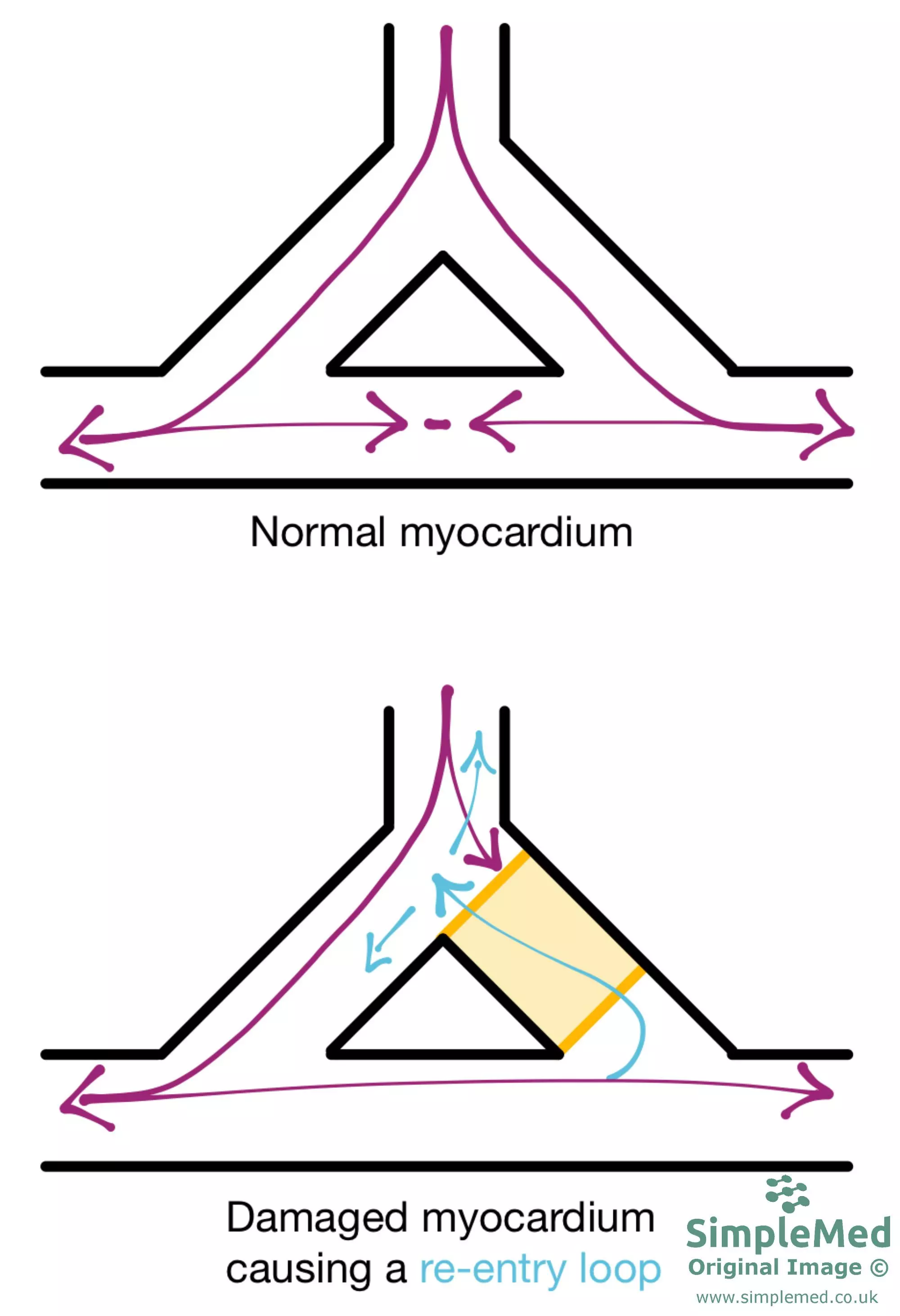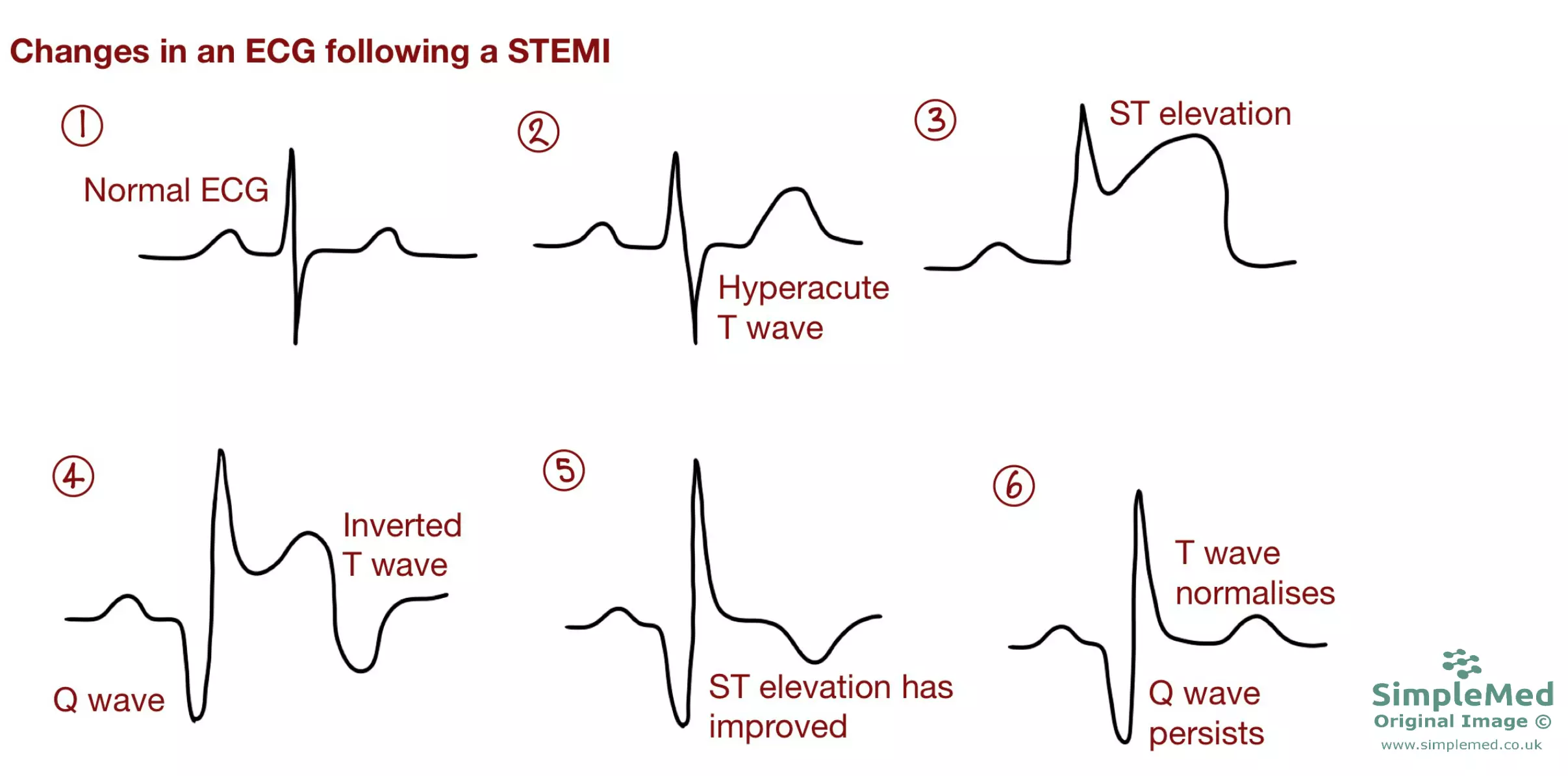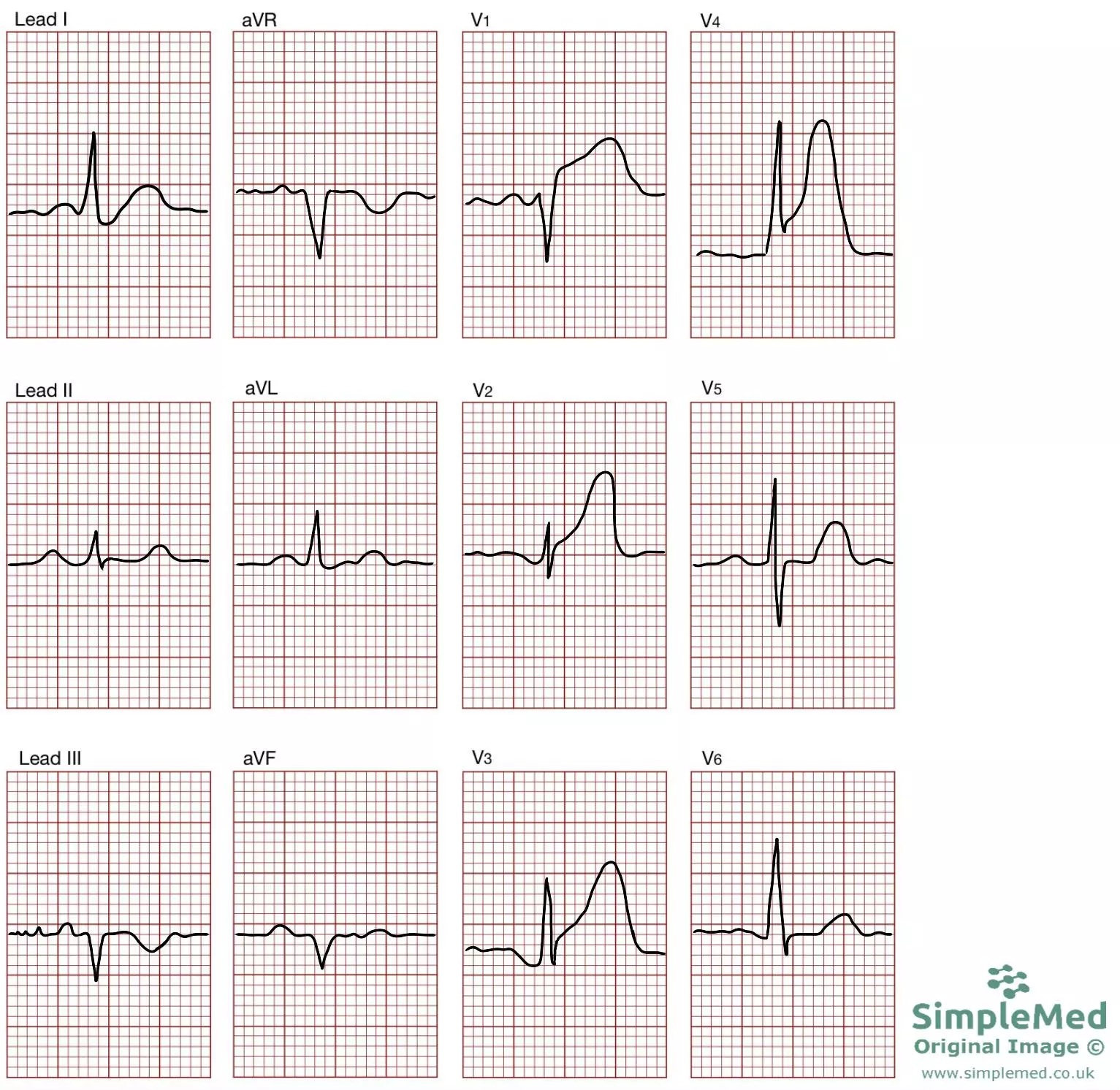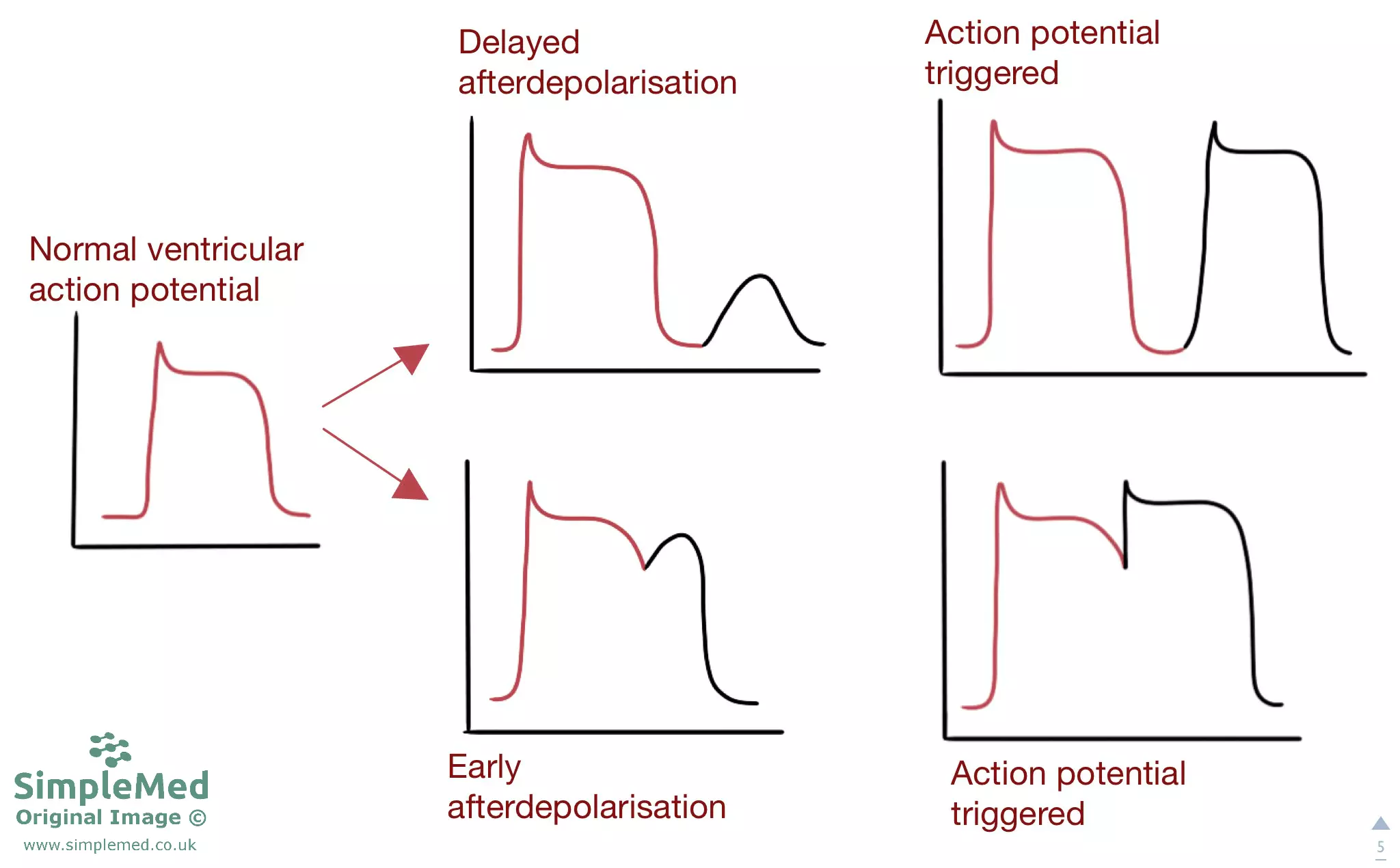By Dr. Thomas Burnell and Bethany Turner
Questions by Dr. Laura Hansell
Next Lesson - Cardiovascular Drugs
Abstract
- There are atrial and ventricular tachycardias which can be easily distinguished by the width of the QRS complex. Both are associated with an increased risk of fibrillation if left untreated.
- STEMI and NSTEMI both appear differently on ECGs in the acute and late phases due to the differences in the thickness of myocardium affected. They both change in appearance with time. STEMIs have an ST elevation while NSTEMIs have either an ST depression or T wave inversion.
- The severity of hypo- or hyperkalaemia will determine how they appear on an ECG. They both become more erratic as the concentration of potassium increases/decreases.
Core
This article is split into different sections:
- Arrhythmias
- Heart block
- Ischaemia and injury
- Electrolyte disturbances
- Afterdepolarisations
All arrhythmias originate somewhere outside of the normal conduction system of the heart. This can be in the atria or ventricles.
An easy rule to determine where a rhythm is originating from is to look at the width of the QRS complex. If it is narrow, this suggests that the rhythm is originating in the atria and travelling to the ventricles via the normal conduction path. If the QRS is broad, this suggests that the rhythm is originating in the ventricles and is not travelling via the normal conduction path (meaning that it takes longer for the ventricles to depolarise, therefore broadening the complex).
There are two common ways that an abnormal rhythm can start to cause an arrhythmia. This can be because of an ectopic focus, or a re-entry loop.
Many tachycardic rhythms are caused by ectopic beats. These are impulses that are generated by an area (focus) in the myocardium, not the sinoatrial (SA) node. Ectopic impulses can be generated by a small area of highly excitable myocardium which can spontaneously depolarise and cause a wave of depolarisation.
The features seen on an ECG depend on where the ectopic impulse originates:
- Atrial ectopics – an abnormally shaped P wave that appears early and is usually followed by a QRS complex due to the impulse being conducted to the ventricles. E.g. atrial fibrillation is caused by many ectopic foci.
- Atrioventricular (AV) junctional ectopics – these ectopics can activate the ventricles by travelling via the His-Purkinje system, therefore giving a normal QRS. Impulses can also retrogradely activate the atria (the impulse travels backwards from the AV node to spread across the atria) to give an inverted P wave, however this can be masked by the QRS complex as the two events happen at the same time.
- Ventricular ectopics – impulses generated by ectopics in the ventricles do not travel via the His-Purkinje system, and instead spread comparatively slowly over the myocardium. Therefore these ectopics give a broad QRS complex as the time taken for the impulse to travel is longer. There can be a compensatory pause as the ventricles have to repolarise before contracting again when the SA node next fires. E.g. ventricular tachycardia.
In the conduction system of the myocardium, there are areas in the pathway where electrical impulses can split and travel down two paths. This usually isn't a problem because when the two impulses meet each other again, they cancel each other out. This allows the myocardium to contract in an even and efficient way.
However, problems arise when there is damage to areas of myocardium that disrupt the normal pathway of electrical impulses, or there are structural abnormalities. In the case of re-entry loops, there is an area of myocardium that is damaged and causes a unidirectional conduction block (electrical impulses can only travel one way through the damaged tissue, and one direction is blocked). Therefore electrical impulses will be able to retrogradely travel through the damaged tissue.
The impulse in a re-entry loop will travel back on itself and take alternative routes thorough the myocardium, causing abnormal contraction of the heart. This is best shown in the diagram below.
If there are re-entry loops, patient can have:
- AV nodal re-entry – if there are 'fast' and 'slow' pathways in the AV node, there can be a re-entry loop which can cause a supra-ventricular tachycardia.
- Atrioventricular re-entry – an accessory pathway between atria and ventricles leads to a re-entry loop. E.g. Wolff-Parkinson-White syndrome.
- Atrial flutter can be caused by a re-entry loop in the atria.

Diagram - Compares the pathways of electrical impulses in normal and damaged myocardium. Note how in the damaged myocardium, the impulse cannot travel down the right limb (purple arrow) due to damage, however, it can travel up the right limb (blue arrow). This is a unidirectional block of conduction. The impulse shown by the blue arrow can now spread across the myocardium causing contraction
SimpleMed original by Bethany Turner
In atrial tachycardia the heart rate is above 100 bpm. As the heart is beating so fast, the T waves and P waves can be occurring at the same time and merge on the ECG. One cause can be a re-entry loop in the AV node, causing AV nodal re-entry tachycardia. A small circuit develops in the AV node and sends off waves of conduction to the ventricles.
Causes include digoxin toxicity, ischaemic heart disease, rheumatic heart disease.

Diagram - Atrial Tachycardia on an ECG. The P and T waves occur at the same time and have merged to form one wave
SimpleMed original by Bethany Turner
Atrial flutter is caused by a re-entry loop in the atria.
The AV node cannot keep up with the rapid atrial depolarisation because it cannot conduct impulses more than around 200bpm. Some P waves are therefore not conducted resulting in AV block. Most commonly it is a 2:1 AV block, i.e. 2 atrial beats (two P waves) for every 1 ventricular beat (one QRS complex). Atrial flutter gives a sawtooth baseline appearance to the ECG because of the consecutive P waves.
The re-entry loop sends off impulses at around 300bpm, making the most common heart rate 150bpm.
Causes include: hypertension, ischaemic heart disease, hyperthyroidism, alcoholism, cardiomyopathy.

Diagram - Atrial Flutter on an ECG. Note how there are 2 flutter waves for every QRS complex
SimpleMed original by Bethany Turner
In AF, rapid, chaotic impulses are generated by multiple ectopic foci in the atrial myocardium. Normal atrial contraction is lost as the atria simply quiver.
Not all impulses generated by the foci are conducted to the ventricles because the ventricles take time to repolarise after a contraction before they can contract again. The impulses that are conducted to the ventricles occur randomly, resulting in irregular R-R intervals. Impulses are conducted from the AV node down the His-Purkinje system in a normal way, therefore the QRS complexes are normal, only irregular.
This can be felt as an irregularly irregular pulse above 100 bpm. Pulse strength will vary due to beat-to-beat variations in cardiac output. This is because the length of time between each ventricular contraction is different, therefore the amount of time the ventricles have to fill with blood will be different. This leads to different volumes of blood being pumped in each heart beat.
In AF, the quivering atria essentially cause stasis of blood as the atria are less efficient at pumping blood into the ventricles. This can result in thrombus formation. A thrombus in the left atrium is more common as blood can sit in the left auricle and clot, which can easily embolise and cause an ischaemic stroke.
Causes include: dilated left atrium, hypertension, ischaemic heart disease, hyperthyroidism, alcohol, cardiomyopathy.

Diagram - Atrial Fibrillation on an ECG. Note the wavy baseline and irregular R-R intervals
SimpleMed original by Bethany Turner
Ventricular tachycardia is caused by an ectopic focus in the ventricular myocardium. VT is identified as three or more consecutive ventricular ectopic beats - these are seen as very broad and bizarre QRS complexes on the ECG. VT is a dangerous rhythm as it can degenerate into ventricular fibrillation.
Causes include: myocardial infarction, ischaemic heart disease, hypertrophic/dilated cardiomyopathy.
In ventricular fibrillation there is chaotic ventricular depolarisation caused by impulses from numerous ectopic foci in the ventricles. As a result, there is no co-ordinated contraction of the ventricles and atria. This results in severely reduced cardiac output, and the patient will go into cardiac arrest.
VF is commonly associated with myocardial infarction, but can also be as a result of Torsades de Pointes (discussed next).

Diagram - Ventricular tachycardia degenerating into ventricular fibrillation. The left hand side shows ventricular tachycardia. Note the wide QRS complexes of the ectopic beats, and the fact there are more than 3 in a row. The right hand side shows ventricular fibrillation. Note the chaotic trace with no normal ECG features
SimpleMed original by Bethany Turner
Torsades de pointes is a polymorphic ventricular tachycardia. This means that there is VF, however, the QRS complexes all look very different.
Causes include: anti-arrhythmic drug treatment and electrolyte abnormalities which cause a long QT interval. Patients can also have a long QT interval with no identifiable cause.

Diagram - Torsades de Pointes on an ECG
SimpleMed original by Bethany Turner
First degree AV block is caused by delayed conduction through the AV node resulting in a consistently prolonged PR interval. The PR interval is >5 small boxes. First degree AV block can develop into second or third degree.
Causes include: ischaemic heart disease and hypokalaemia.

Diagram - First Degree AV Block on an ECG. Note the lengthened but constant distance between the P wave and QRS complex
SimpleMed original by Bethany Turner
There are two types of second degree AV block: Mobitz type I and Mobitz type II.
- Mobitz type I – the PR interval becomes progressively longer until one of the QRS complexes is dropped. The PR interval then returns to normal and repeats the cycle.

Diagram - Second Degree AV Block, Mobitz Type 1 on an ECG
SimpleMed original by Bethany Turner
- Mobitz type II – the PR interval is normal and constant, but occasionally the P wave is not conducted so a QRS complex is dropped. This type of second degree heart block is dangerous as it has a higher chance of progression to third degree heart block.

Diagram - Second Degree AV Block, Mobitz Type II on an ECG
SimpleMed original by Bethany Turner
Another type of second degree AV block where alternate P waves are not conducted. This is a kind of second degree heart block in itself because it cannot be categorised into Mobitz type I or II. It cannot be determined if consecutive PR intervals are the same length or not because there are no consecutive PR intervals.
Third degree AV block is when there is no impulse transmission between the atria and ventricles and therefore they work independently. There is no relationship between the P wave and QRS.
The ventricular pacemaker takes over as an escape rhythm. Escape rhythms occur when the conduction system is blocked, and so the ventricle have to manage themselves and become their own pacemaker. The QRS complex becomes wider because the impulse isn't travelling via the His-Purkinje system. The rate of the ventricular pacemaker is slow and the blood pressure cannot be maintained so a proper pacemaker is urgently required for patients with third degree heart block.

Diagram - Third Degree AV Block on an ECG
SimpleMed original by Bethany Turner
ST Elevation Myocardial Infarction (STEMI) and Non-ST Elevation Myocardial Infarction (NSTEMI)
STEMI and NSTEMI will both be talked about in more detail in the article on Acute Coronary Syndromes.
A STEMI is a full-thickness myocardial infarction. This means that an area of heart muscle is damaged all the way through. This is due to the full occlusion of a coronary artery by a thrombus or embolism.
The ECG and blood test signs of an ECG vary depending on how much time has passed since the event:
- Acutely there is an ST elevation and the T wave becomes taller - hyperacute T wave.
- After a few hours a pathological Q wave develops. The R wave decreases in height and the ST elevation is still present.
- Pathological Q wave: > 1 small box wide, > 2 small boxes deep and ¼ the depth of the R wave.
- The pathological Q wave is denoted with a capital Q rather than the normal small q as the wave is larger than normal.
- After 24 hours, there is a raised troponin I and T (indicating myocyte death).
- 1-2 days later there is T wave inversion and the Q wave becomes deeper.
- A few days later the ST segment normalises but the T wave remains inverted.
- Weeks later the ST and T wave are normal, but the Q wave persists and the R wave remains decreased in height.

Diagram - The changes in an ECG following a STEMI
SimpleMed original by Bethany Turner

Diagram - A 12-lead ECG of an anteroseptal STEMI. This is shown by the ST elevation and the hyperacute T wave in leads V1-V4
SimpleMed original by Bethany Turner
An NSTEMI is a partial-thickness myocardial infarction. This is when an area of myocardium is damaged, but the damage is mainly to the inner part of the myocardium. This can occur when a coronary artery is almost completely occluded by an embolism or thrombus. The ECG changes are slightly different in NSTEMIs compared to STEMIs:
- Acutely, there is either a depressed ST segment or there is an inverted T wave.
- Within hours there is raised troponin I and T on a blood test (indicating myocyte death).
- After a few weeks the ST segment and T wave return to normal.
- No pathological Q wave develops because the infarction is not the entire thickness of the myocardium.

Diagram -The changes in an ECG following a NSTEMI
SimpleMed original by Bethany Turner
Hyperkalaemia makes the resting membrane potential less negative, depolarising it a little. This inactivates some voltage-gated sodium channels so there is a slower upstroke of the ventricular action potential, and a slower heart rate.
In hyperkalaemia, the ECG seen will depend on the potassium concentration in the plasma. All values below relate to an approximate plasma [K+].
- 6.0 mmol/L – tall, peaked T wave.
- 7.5 mmol/L – tall, peaked T wave, flattened P wave and a prolonged PR interval.
- 8.5 mmol/L – tall, peaked T wave, absent P wave and a widened QRS.
- 9.0 mmol/L – widened QRS. The ST segment merges with the T wave causing a sine-wave pattern.
Causes include: reduced renal function, metabolic acidosis, cell lysis (e.g. due to crush injury).

Diagram -The changes seen in hyperkalaemia on an ECG
SimpleMed original by Bethany Turner
Hypokalaemia is a plasma potassium concentration below 3.5 mmol/L. It results in a lengthened ventricular action potential and delays repolarisation. Longer action potentials can lead to early after-depolarisations causing oscillations in the membrane potential. This can result in VF.
As the level of potassium in the plasma decreases, its appearance on an ECG changes:
- First there is a low T wave.
- Then there is a low T wave and high U wave.
- Finally, there is a low T wave, high U wave and a low ST segment.
Causes include: severe diarrhoea and vomiting, metabolic alkalosis, high urine output (e.g. in diabetes or with osmotic diuretics).

Diagram - The changes seen in hypokalaemia on an ECG
SimpleMed original by Bethany Turner
Delayed afterdepolarisation (DAD)
DAD is when the membrane depolarises (without stimulation) soon after repolarisation following a contraction. This is more likely if there is a high intracellular calcium as this can trigger contractions when there shouldn’t be one. The depolarisation can reach threshold potential, initiating an action potential, causing the heart to contract.
Early afterdepolarisation (EAD)
EAD is when the membrane depolarises (without stimulation) during repolarisation following a contraction. This is more likely to occur if there is a long QT interval as the action potential is longer. Consecutive EADs lead to oscillations in the membrane potential which can result in VF.

Diagram - The changes in an ECG in delayed and early afterdepolarisations
SimpleMed original by Bethany Turner
Edited by: Dr. Ben Appleby
- 35664

